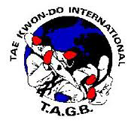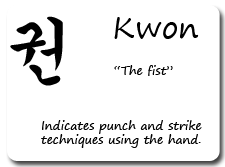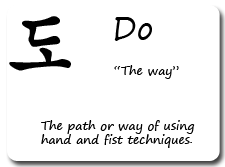About Tae Kwon-Do.
To the Korean people Tae Kwon-Do is more than a mere use of skilled movements. It also implies a way of thinking and life, particularly in instilling a concept and spirit of strict self-imposed discipline and an ideal of noble moral re-armament. In these days of violence and intimidation, which seem to plague our modern societies, Tae Kwon-Do enables the weak to possess a fine weapon to defend his or herself and defeat the opponent as well. Of course, wrongly applied, Tae Kwon-Do can be a lethal weapon. Tae Kwon-Do was introduced to Great Britain in 1967 by Rhee Ki Ha.
| Find out more: |
|
Find out more by clicking on any of the headings below. If theres a question not answered here contact Mr Downer and he will be happy to get back to you.
-
More About TaeKwon Do
Tae Kwon-Do is an ancient form of unarmed combat practiced for many centuries in Korea. It became perfected in its present form by Major General Choi Hong Hi (1918-2002), and has been scientifically developed and modernised since its introduction to the world on 11th April 1955. Translated from Korean, Tae means to jump, kick or smash with the foot, Kwon means to punch, strike or destroy with the hand and Do is art, method or way. It is proven to be the most powerful system of self defence ever devised.
Tenets of Tae Kwon-Do
What are the five tenets of Tae Kwon-Do?
The Tae Kwon-Do tenets help students to gain an insight into this way of thinking and a strong emphasis in the curriculum is the use of the tenets to enhance ones wellbeing.
- Courtesy: To be polite to your instructors, seniors and fellow students.
- Integrity: To be honest with yourself. You must be able to define right from wrong.
- Perseverance: To achieve a goal, whether it be a higher grade or any technique you must not stop trying, but persevere.
- Self Control: The loss of ones temper when performing techniques can be very dangerous and shows a lack of control. To be able to live, work and train within your capability shows good self control.
- Indomitable Spirit: To show courage; when you and your principles are pitted against overwhelming odds.
Tae Kwon-Do Oath
As a student of Tae Kwon-Do, I do solemnly pledge to abide by the rules and regulations of the Tae Kwon-Do Association, to strive always to be modest, courteous and respectful to all members, in particular my seniors, to put the art into use only for self defence or defence of the weak and never to abuse my knowledge of the art.
Key Dates
11th April 1955 Tae Kwon-Do inaugurated.
2nd July 1967 Tae Kwon-Do introduced to Great Britain.
.
-
The History Of TaeKwon Do
What is Taek Kyon?
Taekyon, or Taek Kyon is a traditional koreanmartial art, stemming from Soobak which was first practiced in korea during the Koguryo Dynasty (37 BC - AD 668). It spread to the Silla kingdom and became the bare handed way of fighting of the Hwarang. At the height of its popularity even the king practced taek kyon and matches were frequent. However, the next king outlawed taek kyon matches, disillusioned by the gambling which took place around them (where people would gamble away their wives and houses), thus making it a purely military art. Soobak eventually separated into different segments - grappling, kicking etc. Taek Kyon being one such segment. Taek kyon movements are very fluid and dance-like with the practitioners constantly moving. It does not have the hard snap kicks of Tae Kwon-Do but a softer way of generating power.
General Choi Hong HI.
General Choi Hong-hi, born 9th November 1918; died 15th June 2002. Born in what is now North Korea when it was under Japanese occupation, Choi fled to Japan to complete his education after a wrestler was set on his trail following a gambling dispute. In 1942, he was drafted into the Japanese army, but was imprisoned for attempting to escape to join the opposition Korean Liberation Army in 1945. Only the liberation of Korea saved him from the death penalty. After the war, the division of Korea between north and south left him unable to return to the land of his birth. He rose quickly in the new South Korean Army and, two years after the outbreak of the Korean war in 1950, he created an officer training programme and an infantry division that provided Tae Kwon-Do instructors. After the cessation of hostilities in 1953 his rise continued, And in 1961 he supported the military coup d'etat, but suffered a setback when General Park Chung-Hee emerged as the new president. In the late 1940s, Park had received a death sentence, later rescinded, from a military panel that had included Choi,who was thus forced to retire from the military following the coup. In 1962, he was sent to Malaysia s ambassador, but after his return to South Korea in 1965 he continued to find life under the Park regime so intolerable that in 1972 he left for Canada. Choi took the headquarters of the ITF to Toronto with him, and South korea responded by forming a new organisation, the World Taekwondo Federation (WTF), based in Seoul. Choi's final years were marked by his efforts to return to North Korea. He introduced Tae Kwon-Do there in 1980.
.
-
History of the T.A.G.B
History Of The T.A.G.B.
Tae Kwon-Do's Popularity was well established world wide by 1983, however political differences within Korea and within the two world governing bodies, the international Tae Kwon-Do Federation (ITF) and the World Tae Kwon-Do Federation (WTF) led to internal disagreements and threatened to tear the world of Tae Kwon-Do apart. Several attempts were made to unite the two Tae Kwon-DO organisations, but these were unsuccessful.
it was largely due to this that in August 1983 it was decided to form, in the UK, an organisation that would be run on principles, far more democratic than were permitted by the two forementioned groups. This became the basis of the Tae Kwon-Do Association of Great Britain (TAGB).
Five years later, in April 1988, the TAGB became a founder member of the British Tae Kwon-DO Council (BTC). The BTC is the only body recognised by the United Kingdom Sports Council and it incorporates 11 different organisations and represents some 45,000 plus Tae Kwon-Do practitioners.
The TAGB, with over 25,000 members represents the next stage in the development of Tae Kwon-Do. With its grounding in the ethos and tenets which were first adopted by the Hwa Rang over 2,000 years ago and its open acceptance and constant development of patterns, training techniques and ideas, it stands poised to take this ancient fighting form and make it a martial art for the 21st century, successfully linking the distant past with an equally distant, and certainly no less wondrous future.
In view of this , in 1983 , a new world body was formed called Tae Kwon-Do International (T I). The new body encompasses both ITF and WTF stylists, it is entirely non-political in orientation and its sole aim is to promote the benefits of Tae Kwon-Do as a sport and as a martial art worldwide. The TAGB is a founding member of this new organisation.
-
TaeKwon Do Patterns
Tae kwon-Do Patterns
What is a pattern (tul)?
A pattern is a set of fundamental Movements set in a logical sequence to deal with one or more imaginary opponents to the rapid destruction of the attackers. Patterns are a barometer used to evaluate the students progress.
Why do we perform patterns?
We practise patterns to improve our Tae kwon-do techniques to develop sparring techniques, to improve flexibility of movement, master body shifting,develop muscles, balance and breath control.They also enable us to aquire techniques which cannot be obtained from other forms of training.
Why are there twenty four patterns?
The reason for twenty four patterns in Tae kwon-Do is because the founder Major General Choi Hong Hi compared the life of man with a day in the life of the earth and believe that some people should strive to bequeath a good spiritual legacy to coming generations and in doing so gain immortality. Therefore , if we can leave something behind for the welfare of mankind, maybe it will be a most important thing to happen in our lives, as the founder says: "Here i leave Tae Kwon-Do for mankind. As a trace of a man of the 20th Century, the 24 patterns, one day or all of my life"
The following points should be considered when performing patterns.
1. Patterns should start and end on the same spot. This will indicate the performers accuracy.
2. Correct posture and facing must be maintained at all times.
3. Muscles of the body should be tensed or relaxed at the appropriate moments in the exercise..
4. The exercise should be performed in a rhythmic movement with absence of stiffness..
5. Each pattern should be accelerated or decelerated according to instructions.
6. Each pattern should be perfected before moving on to the next.
7. Students should know the purpose of each movement.
8. Students should perform each movement with realism.






